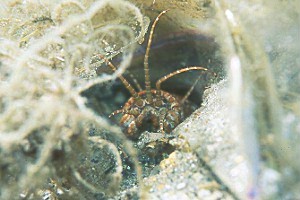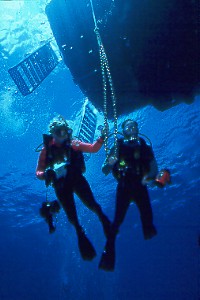|
In the Olden Days, before the digital camera
and the computer, photographers could, with some effort in the darkroom,
dodge, burn, and sandwich their prints. It was considered unethical to
add or subtract elements. If you did so, it was expected of you to disclose
what you did - and then your print was viewed as more of a work of art. And
there was nothing wrong with that.
Coming from the old school, when the
computer age came, with all of its ramifications, I was
appalled at what some photographers were doing with their
photos. Somehow, putting polar bears with penquins on ice
flows just didnít seem right -(and it wasnít, considering they
belong on different poles). I didnít mind so much that they
had the computer skills to add and subtract their subjects,
but I did mind when they claimed they were photographs taken
"as is". It is one thing to use the computer as a darkroom -
and I am now seeing its value as such - to remove backscatter,
adjust exposure, or crop your photo. It is another thing to
use your computer to manipulate your photo and tout it as a
photograph taken in real life. Now that we are in a age
where nothing we look at can be considered genuine, it is
discouraging for beginning photographers unable to achieve the
same results in the field or underwater. Wildlife magazines
and films routinely brings us images of animals that startle
us with their drama and intimacy. The questions that now arise
are whether the shots were manipulated in the field, in the
computer, or taken at the ever popular game farm. We donít
know anymore what is real (or was it Memorex?)

This unknown subject is about 2"
long -coming out of its hole that it surrounded with bits of
plastic and old fishing line. I could have moved that material
to get a better photo, but that would have disturbed its home.
I felt it was better to get a more realistic photo of its
environment. Unfortunately, I did not realize noone really
knows what it is!!! If you do, get in touch with me. Taken
with a Nikon N90- 60 mm lens in 8' water in the
Intercoastal Water off West Palm beach.
There is another side to this ethical
coin. Photographers that shoot birds, other wildlife,
fish (above water shots of caught fish), nature and underwater
seem to have different ethical standards on how that shot can
be taken. Some groups have no qualms about manipulating their
subjects in the field. I have seen photographers damage
surrounding areas to photograph a flower, disturb the nests of
birds, drug fish, and move underwater subjects to put them on
a more colorful background. The North American Nature
Photography Association has issued a statement on ethical
field practices. The condensed version is - (and this applies
to underwater!) - environmemtally, have a good knowledge of
your subject so as not to interfere, nor impact them in any
way. Back off and use longer lenses. Help minimize cumulative
impacts and maintain safety. Inform others if you see anyone
engaging in inappropriate or harmful behavior - many people
unknowingly endanger themselves and animals. Donít argue with
those that do not care, report them to the proper authorities.
(For more information about NANPA, log on to their website at
www.nanpa.org).
As a
photographer, I feel we have a moral obligation to photograph
the moment as it was, to show others who canít see
wildlife in its natural state, the true behavior of natureís
inhabitants. I will not handle, manipulate or disturb my
subjects in any way. What you see is what you get, for better
or worse.
I feel that if publishers accept photographs that
are known to be manipulated, whether in the computer or in the
field, it should be annotated with "Capture", "Digitally
manipulated", or "Digital composite". If it is a true natural
shot, note it as "Wild". Disclosure is very important.
Disclosure doesnít necessarily lessen the impact of the image,
but it does put it in the proper perspective. We may think we
are fooling people with some of these incredible shots that we
know couldnít possibly exist, but we are only fooling
ourselves. Future generations who will no longer know what is
real, because so much of life now is one big special effect.
Any other comments and issues youíd like to see
addresssed? Contact me at pgoldberg@goldenimages-photo-scuba.com.
|



